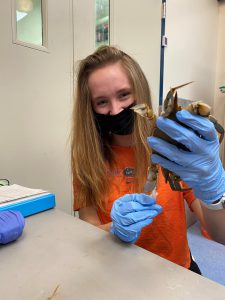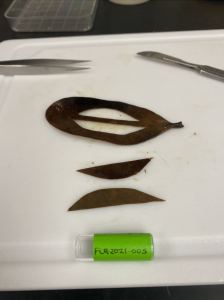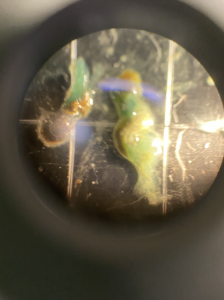Written by 2021 Summer Intern, Meredith Anderson
 This summer, I had the opportunity to intern with UF/IFAS Nature Coast Biological Station. Hosted by the United States Geological Survey Wetland and Aquatic Research Center, I worked on Dr. Demopoulos’ and Dr. Bourque’s project that focused on the functional equivalency of mangrove restoration in southwest Florida. Overall, this internship provided me with an amazing opportunity to conduct lab work, analyze data, and assist in the day-to-day tasks of working within a federal, scientific agency.
This summer, I had the opportunity to intern with UF/IFAS Nature Coast Biological Station. Hosted by the United States Geological Survey Wetland and Aquatic Research Center, I worked on Dr. Demopoulos’ and Dr. Bourque’s project that focused on the functional equivalency of mangrove restoration in southwest Florida. Overall, this internship provided me with an amazing opportunity to conduct lab work, analyze data, and assist in the day-to-day tasks of working within a federal, scientific agency.

Mangrove Restoration
Now, why are mangroves important and need to be restored? Mangroves are an incredibly important part of an ecosystem as they provide a series of services such as storm protection and carbon sequestration. However, over the years, these unique ecosystems have dwindled worldwide, and consequently, there has been a series of efforts to establish which method of restoration warrants the greatest functional success rate. Within the Demopoulos lab, their research encompasses how the hydrologic regime is affected, which often goes unaddressed when projects solely plant seedlings. Through this approach, the trophic structures are studied through isotopic analysis that compares hydrologically restored and unrestored areas with mature mangrove forests. As the research has progressed, the data suggests a restored hydrological regime may facilitate increased trophic complexity in degraded and transition zones.
 Cut. Dry. Crush. Repeat.
Cut. Dry. Crush. Repeat.
Over the summer, I was fortunate enough to gain valuable lab experience where I processed samples from the most recent excursions. While the pandemic hindered chances of fieldwork, I learned first-hand how to dissect, dry, and crush different taxa. I began with mangroves leaves (black, white, red, and detritus) from five different sites that included reference, transition, and degraded zones. Each sample involved cutting a smaller section with a scalpel and tweezers to dry over a few nights that would then be crushed with a mortar and pestle. After processing over one hundred leaf samples, I will never look at a leaf the same way.
 Later on, I learned how to conduct the same steps to marine gastropod species, ranging from Cerithiidae to Littorinidae, but now add a hammer and microscope to the dissection. Each marine gastropod sample needed to have the operculum and any shell remnants removed before drying and crushing. This lab work taught me that patience and precision are all essential skills to have within the laboratory setting. With the conclusion of my internship, I had the opportunity to analyze new isotopic data focusing on each site’s sediment fauna and how they correlate to a variety of carbon sources by looking at their C13 and N15 values.
Later on, I learned how to conduct the same steps to marine gastropod species, ranging from Cerithiidae to Littorinidae, but now add a hammer and microscope to the dissection. Each marine gastropod sample needed to have the operculum and any shell remnants removed before drying and crushing. This lab work taught me that patience and precision are all essential skills to have within the laboratory setting. With the conclusion of my internship, I had the opportunity to analyze new isotopic data focusing on each site’s sediment fauna and how they correlate to a variety of carbon sources by looking at their C13 and N15 values.
 Aquaria Responsibilities
Aquaria Responsibilities
In addition to my lab work, I learned the ins and outs of aquaria systems. Despite my fear of accidentally killing one of the fish, I was responsible for feeding the lab’s fish each day I came in. On top of that, I learned how to clean the tank’s protein skimmers and filter socks. All in all, I learned more about aquaria systems than I ever thought I would. I would like to thank everyone involved with the Demopoulos lab, the USGS Wetland and Aquatic Research Center, and the Nature Coast Biological Station. I am forever grateful for the experiences I had this summer and how they will connect with my future career in the sphere of marine ecology.
 0
0
